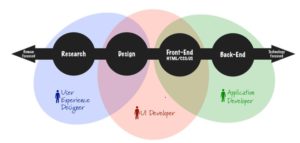UI designs and patterns are so much important these days as they play one of the vital roles in capturing the audience’s attention. The more is the traffic engagement, better are the chances of your brand/product’s promotion.
WHAT ARE THE FACTORS THAT ARE INFLUENCING UI DESIGNS IN 2020?
We intend to use UI trends not only to satisfy users aesthetic requirements but also provide them with a high level of usability. A wise combination of these trends will lead to happier users, and hence your product’s success.
HOW TO CHOOSE UI DESIGNS?
Change Your ‘Design-First’ Approach!
The as always design-first approach for digital products has now become a secondary attribute this year.
Why? Well because now this has been observed that the designs should be such that these designs should improve people’s lives and also help meet business goals.
In 2020, the UI trends will match these requirements more than ever before.
They prioritize speed, simple page designs, mobile-first approach, and most importantly, recreate with artificial intelligence.
Here are some UI trends of 2020:
1. Full screen smartphones:
Most phones have lost their borders and have rounded edges. This changes their interface quite a bit. Now this may pose challenges for the designers to use sharp-edged elements in their mobile via UI and app design.
Moreover, iPhones don’t have home buttons anymore and Android phones are also losing the on-screen buttons to save space for the displayed content.
To achieve a cleaner screen, the navigation relies on gestures which can also be a challenge designers have to face. It is a bold move to make users learn new navigation styles. That is why it became a crucial problem for a newly hired designer to help him understand the navigation process.
Apps that are running on the latest operating systems of these full screen smartphones are implementing the Dark mode.
2. Unique illustration and animation
Moving elements and unexpected animations activated by scrolling make users curious, and also makes them scroll further to see what happens next.
This dynamism makes it easier to capture user’s attention and explain what the company or brand has to offer at a glance. An enjoyable illustration can give websites or mobile apps their own personality, thus making them more memorable.
Nevertheless, whenever a change is made it should be tested keeping the conversion rates in mind. But if used right, minimalistic with a touch of neat 3d illustration, a service website can still look professional while up-to-date.
3. Storytelling!
The ability to tell great stories around a digital experience will continue to trend among the best.Text style by itself will still not do enough. Copywriting has become one of the most important elements for a great user experience. While the style captures the users attention, the narrative engages them with a brand because it makes them feel like they are part of the story. This, in turn, keeps users from simply scanning through the content. Power of UX writing is also very useful.
4. Augmented Reality
In 2020, web design trends will involve thinking outside the box, or rather sticking to the grid. We need to forget UI fixed to screens. Instead, we should emphasize interactions which feel like they take place within the real-world environment. Google and Apple have already introduced their own AR development platforms, ARCore and AEKit, that blend the physical and digital worlds.
5. Virtual Reality
VR headsets bring most of the excitement to the gaming audience for now, VR experts predict that since the Oculus Quest launched, many opportunities have opened for other industries. For instance it would be a great possibility for healthcare to help cure phobias or in education to enhance interaction.
Designers should also be prepared and look out for the opportunity of creating virtual spaces for collaborations. Even doing so, we have to be mindful that not all users will have a VR headset so we have to think of a mixed platform solution.
6. Artificial Intelligence
AI will be it integrated into almost every possible product. As AI is capable of collecting huge amounts of data, we will notice more and more personalised products that are 100% tailored to each and every individual’s need.
Products will learn more and more about the users based on their behavior, which will help with creating a better user experience. This eventually could lead to a higher conversion rate. Lots of time will be saved for the designers too. Instead of building hundreds of onboarding screens, we will be able to focus on delivering smoother experiences.
This will going to replace designers though. Moreover, it will probably ease and benefit our work.
7. Responsive colors
Instead of one symbolic brand color, more companies will aboard the idea of switching to a dynamic color system that takes on the color of its environment.
8. Oversized, bold typography
It doesn’t only look good, but this eye-catching solution also excites and shocks the visitors of a website, and makes them spend more time on it.
In contrast to UI, considering the user experience aspect, a large text that doesn’t say much might not bring the results we expect. Yes, the user will be curious and will probably scroll through the page to see what happens next, but they might not convert.
9. Broken grid, asymmetrical layouts
Breaking the rules gives the website a playfulness which makes users curiously explore further. But be mindful about the purpose of the created website.
10. Skeuomorphic design
Skeuomorphism refers to elements that are designed in a very realistic way so that they simulate a real-life object with as much proximity as possible.
When it is done right it really can be very nice looking, but we have to consider that we live in a fast and ever-changing world. Because of that, we have to consider the excessive amount of work it takes both to design and develop skeuomorphic design.



